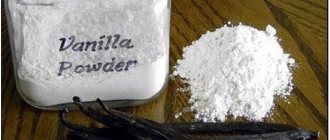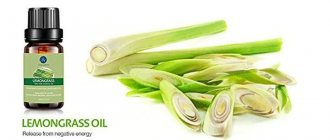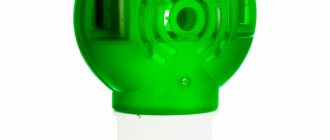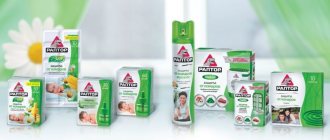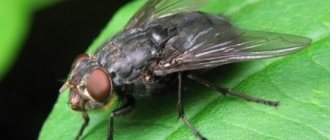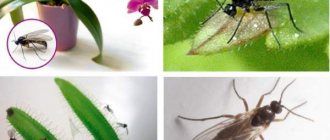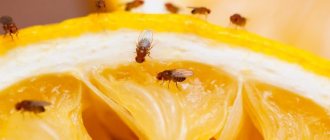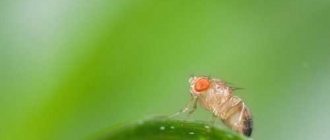Vanillin against mosquitoes is one of the mild and hypoallergenic products suitable for children. The aroma of the spice repels bloodsuckers, but does not cause such a strong allergic reaction that can occur when using clove oil or citronella.
Preparations based on vanillin
The strong sweet smell of vanilla helps drive bloodsuckers away from the home, and the bitter taste prevents particularly persistent ones from drinking blood. In the latter case, vanilla against mosquitoes will only help if the substance was applied directly to the skin.
Important!
If you have asthma or an allergy to the spice, vanillin cannot be used against mosquitoes. People suffering from asthma should generally not use substances with strong odors, including essential oils.
Vanilla is added not only to baked goods, but also to body care creams, laundry detergents, and sprays. This way they kill two birds with one stone: they give a pleasant smell to clothes and the body and drive away insects. To repel blood-sucking insects, real vanilla essential oil is used, which works similarly to other similar substances. But if you don’t have oil, you can make your own mosquito repellent.
Important!
When preparing repellent preparations, you should not use vanilla sugar. Sugar contains very little vanillin and is not able to repel bloodsuckers. And the sweet taste will attract other insects that prefer to feed on sugars.
How does it work?
Vanillin for midges is a folk remedy, the effect of which has long been known. There has been no scientific research into the insect repellent mechanisms of vanilla. The main assumption why the plant helps against blood-sucking parasites is the sharp, specific aroma of the fruits of a perennial vine. The smell, which evokes pleasant sensations and associations in humans, has an alarming, frightening effect on insects. Scientists suggest that the reason for this effect lies in the biological characteristics of the perennial vine.
- Before becoming a cultivated plant cultivated in several countries, the pearl of the rainforest was native to Mexico.
- An orchid with sought-after fruits grows on trees, held in place by adventitious roots and protected from the sun. In its native habitat, it is pollinated only by bees of one species.
- Beneficial insects have only a day to pollinate while the flower is open. If they do not have time to do this, the flower falls off and does not bear fruit. Probably, the ability of the smell to repel other insects, except for one bee species, is based precisely on this.
- The second assumption is the long ripening of the pod (3/4 years). The sweet aroma repels pests of the fragile box.
Traditional methods are based on practical observations. Seeing that the smell of the confectionery spice helps get rid of mosquitoes, people have developed several ways to safely apply it to the skin exposed to bloodsuckers.
This helped to be calm on the street in the evening. Then it was discovered that vanilla has the property of repelling midges, fleas and ticks. It began to be used as a means for a relaxing stay in nature and ridding pets of parasites.
The beneficial properties of vanilla have been adopted by cosmetologists, veterinarians, manufacturers of products to repel blood-sucking insects, industrial chemistry and even medicine. Traditional healers have several effective recipes and methods for making vanillin solution against midges.
Children's version
To repel bloodsuckers from baby strollers, vanilla water is the most popular. This is the easiest to prepare and the safest mosquito repellent for a child under one year old, as it is applied to surrounding objects without affecting the child’s skin. Vanillin mosquito repellent recipe for children:
- 2 sachets (1 g each) of vanilla powder per full glass (250 ml) of warm water; stir, pour into a spray bottle and spray the room and things;
- instead of vanilla powder, add a few drops of concentrate to the water;
- pour a few crushed pods with half a glass of water; In order for the released vanilla oil to evaporate better, the composition can be periodically heated.
Water with vanilla is the safest option for a child. But the solution quickly loses its properties. For high-quality protection, the treatment must be repeated every half hour.
If you need to treat a large area, you can buy a large bag of powder (20 g). This is more profitable, since usually the larger the packaging, the cheaper the unit of product costs. When using a large bag, dilute vanillin in 1 liter of water.
What not to do if you are bitten by mosquitoes
Mosquito bites should not be rubbed or combed, no matter how much you might want to do so. The result of such actions can be not only the appearance of scars due to skin damage, but also an increased risk of infection or the development of an allergic reaction.
Most often, medical attention for mosquito bites is not needed, and it is enough to endure the unpleasant itching sensation for a couple of days. But there are exceptions when it is necessary for a doctor to assess the condition of the bite site. These include:
- If the number of bites is very large and they cover most of the body;
- The spots are quite large, their diameter exceeds 5 cm;
- The lesion is located very close to the eyes;
- Swelling of the skin and severe itching do not go away within several days, even with the measures taken;
- Due to the mosquito attack, the body temperature rose;
- Severe headache bothers you;
- The general condition of the body began to deteriorate.
Each of these signs may indicate an allergy to mosquito saliva or the development of mosquito encephalitis. Therefore, failure to seek qualified help in a timely manner can cause damage to health.
This is especially important when the above symptoms appear in children under 5 years of age.
For adults
Vanillin with baby cream to protect against insects
If you are not allergic to vanilla, you can prepare an ointment with your own hands. To do this, you need a cream with a minimum of active ingredients. The best option is baby skin care cream. When mixing, the proportions of vanillin and cream should be 1:10: for one gram of vanillin powder 10 g of baby product. Vanillin and baby mosquito repellent cream have one significant drawback: oily preparations are not recommended for use in hot, quiet weather, as it clogs pores and blocks sweating. And in windy weather the bloodsuckers get blown away.
On a note!
If cream is not available, you can use Vaseline. But Vaseline is much oilier and is not absorbed into the skin.
Another popular recipe suggests using vegetable oil: add a couple of packets of vanilla powder to 150 g of heated oil and mix thoroughly. It is better to apply this mixture to clothes, as dust will settle on oiled skin.
Important!
All preparations applied to the skin must be washed off after 3-4 hours.
There are tips to rub dry vanilla pods into the skin. It is better to make an aqueous solution. In addition to the risk of allergies from direct contact of the spice with the skin, dry pieces of pods will scratch the skin.
Warnings and Safety Precautions
Whatever product you use, you should always remember safety precautions. Even harmless vanilla in combination with other ingredients can cause harm if you do not listen to the recommendations.
You need to know that:
- Any product that is applied to the epidermis must be washed off with water after 4-5 hours. If this is not done, the pores will become clogged, resulting in pimples and blackheads.
- Allergy sufferers and children are first tested for tolerance. You need to apply a small amount of the prepared repellent to the area where the skin is delicate (elbow or wrist area), and wait 2-3 hours. If redness, itching and other manifestations are not detected, then the product can be used.
- It is prohibited to use vanilla repellent for ENT diseases. A strong odor can lead to spasms and worsening cough.
- Do not increase your concentration at your discretion. Otherwise, this will lead to health problems.
- Do not prepare products from spoiled vanillin. The smell of expired powder will not help repel mosquitoes, midges and other insects.
- If coughing, redness, dizziness or other phenomena occur, stop using the product.
- It is dangerous to rub or spray the liquid composition into the affected epidermis. This includes wounds, abrasions, burns, dermatitis, etc. This is fraught with the appearance of inflammation and suppuration.
- Do not replace vanillin with vanilla sugar. The second option will only attract bloodsuckers.
If it is windy outside, it is better to give preference to ointments, creams and oil formulations. These will not quickly disappear and will reliably protect against harmful insects.
Vanillin is an effective remedy for midges and mosquitoes when properly prepared and in proper proportions. In most cases, the aromatic additive does not cause harm, but you should refrain from using the repellent if you have bronchial asthma, problems with the respiratory tract, or a tendency to allergic reactions.
Get rid of the annoying pest
In order to get rid of midges, you just need a little patience, a few simple tricks and time. You can get rid of fruit flies at home without using toxic chemicals. If a midge has infested somewhere far from food, it is quite reasonable and quick to use chemicals, but at home, in a one-room apartment, this will not always work, and it is harmful. Therefore, alternative remedies from “grandmother’s advice” are just what you need. Traditional methods will definitely be cheaper, and it’s very easy to prepare them at home.
Before purchasing chemicals, try traditional methods first
Recipe No. 1 “Trap”
The name speaks for itself. We take a jar, a plastic yogurt cup or a regular disposable one, a container that you don’t mind using for such a product. Pour a little juice, compote, wine, apple cider vinegar, sweetened water with a piece of any fruit (preferably grapes or apple) - your choice. Next, we make a paper cone with a small hole at the top and, turning the base upside down, close the container with the bait.
Similarly, you can close the jar with the bait with cling film, after making several holes in it, or drop a little dishwashing detergent into the liquid. The principle of operation is such that the midges attracted by the bait do not fly back into the jar. The main thing is to monitor the quantity and change the trap often.
Recipe No. 2 “Adhesive tape”
You have used the so-called flytrap more than once. So, to get rid of midges, it can also be used. However, fruit flies react poorly to a regular flytrap, so lightly sprinkle it with fruit juice or wine.
Recipe No. 3 “Smoking”
Perhaps one of the radical and little-used, but it has a right to exist. We take camphor oil, pour it onto a frying pan, a frying pan will do, but keep in mind that you can’t wash it off so easily, and heat it until steam appears. We spread this “aroma” throughout the desired room, it’s not pleasant, but judging by the reviews it’s effective.
What plants do pests prefer?
Drosophila loves most: violets, callas, cyperus, orchids. If they are not there, it feeds on any other flower.
Sciarides love flowers with dense foliage and take root at the roots. They prefer to live in pots with ficus, Decembrist, violet, aloe and azalea.
Midges pose a great danger to seedlings, cuttings, and young potted plants with a shallow root system. At risk: geranium, violet, orchids, poinsettia, gerbera, carnation, cacti. The root system of such plants does not go deep into the ground, therefore, if they are overwatered, water stagnation occurs in the upper part of the soil. This leads to the proliferation of fungus gnats.



